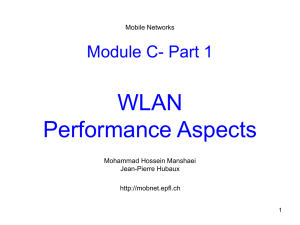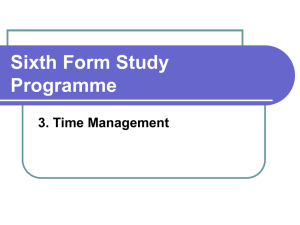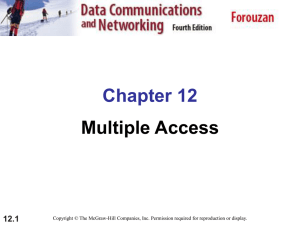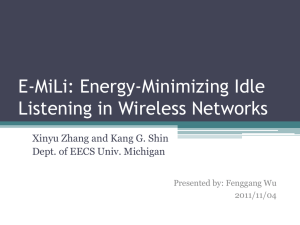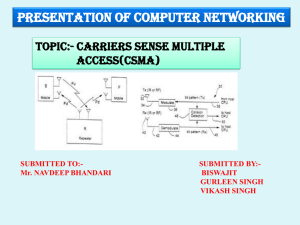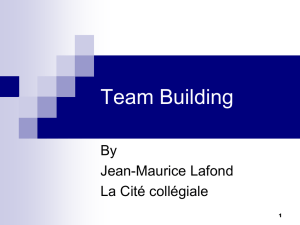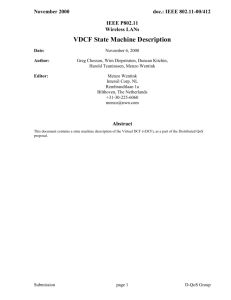Wireless Networks - book - ECE
advertisement
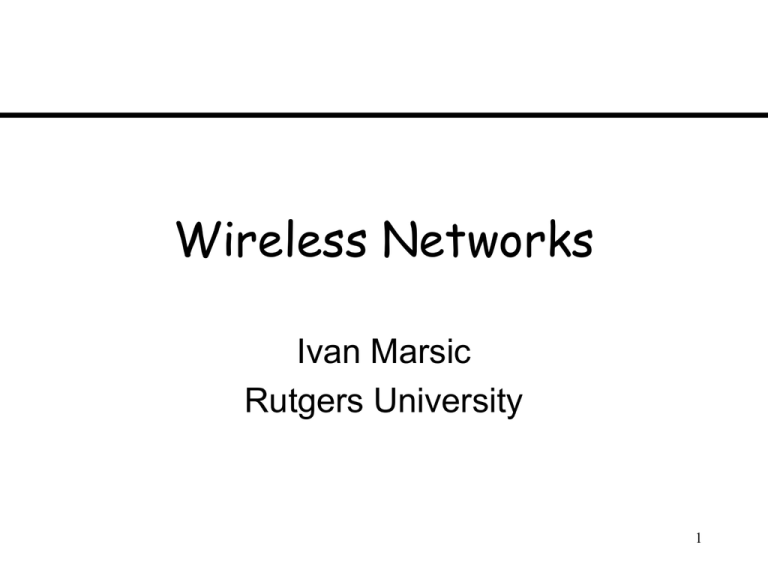
Wireless Networks
Ivan Marsic
Rutgers University
1
ISO OSI Protocol Stack
• Protocol at layer i doesn’t know about protocols
at i1 and i1
Application
4: Transport
• Reliable (TCP)
• Unreliable (UDP)
3: Network
• End-to-end (IP)
• Routing
• Address resolution
2: Link
• IEEE 802.11 WiFi
• IEEE 802.3 Ethernet
• PPP (modems, T1)
1: Physical
MAC
• Radio spectrum
• Infrared
• Fiber
• Copper
2
Infrastructure vs. Ad Hoc (1)
(a)
(b)
3
Infrastructure vs. Ad Hoc (2)
(c)
(d)
4
Waves
5
1 KHz
1 MHz
LF
30 KHz
1 GHz
(AM radio)
MF
300 KHz
UV
Visible
Infrared
EM Spectrum Allocation
1 THz
X rays
1 PHz
1 EHz
(SW radio) (FM radio - TV) (TV – Cell.)
HF
VHF
UHF
3 MHz
30 MHz
300 MHz
ISM
902 MHz
Gamma
rays
928 MHz
Cordless phones
Baby monitors
(old) Wireless LANs
2.4 GHz
2.4835 GHz
IEEE 802.11b, g
Bluetooth
Microwave ovens
Freq.
SHF
30 GHz
Freq.
5.785 GHz
Freq.
3 GHz
UNII
5.725 GHz
IEEE 802.11a
HiperLAN II
6
Communication Process
Information
Source
Communication
Channel
Transmitter
Receiver
Destination
Noise
Source
Source
Data:
0 1 0 0 1 1 0 0 1 0
Input
Signal:
S
Noise:
N
Output
Signal:
S+N
Sampling
Times:
Source
Data:
Decision
threshold
0 1 0 0 1 1 0 0 1 0
Data
1 1 0 0 1 1 1 0 1 0
Received:
Bits in error
7
Decibel definition
Power in
Link,
channel,
repeater, or
node
Power out
8
Three dots running
at the same speed
around the circle in
different lanes:
Displacement
Fourier Series Approximation
Resultant
Time
60
90
30
180
0
60
30
120
90
150
240
210
300
270
360
330
Angular phase of fundamental wave
9
Phase Space
Phase space:
Amplitude
/2
Period (T)
Frequency = 2 / T
A
[rad / s]
A
Time (t)
0
2
Phase ()
A sin ( t )
3 / 2
10
Wireless Transmission and
Receiving System
Modulator
Demodulator
Error Control
Encoder
Error Control
Decoder
Source Encoder
(Compress)
Source Decoder
(Decompress)
Information
Source
Destination
Receiver
Transmitter
Communication
Channel
11
Modulation
Carrier signal
Carrier signal
Analog message signal
Digital message signal
1
0
1
1
0
Amplitude-modulated (AM) signal
Amplitude-shift-keying (ASK) signal
Frequency-modulated (FM) signal
Frequency-shift-keying (FSK) signal
Phase-modulated (PM) signal
Phase-shift-keying (PSK) signal
12
Modulation—PSK
01
010
011
135
90
10
90
0
00
100
11
0011
0101
0100
0000
0001
1001
1000
1100
1101
1011
1010
1110
1111
000
270 315
101
(a)
0010
001
225
270
0110
45
180
180
0111
111
(b)
(c)
110
00
01
135
45
225
10
315
11
13
Amplitude
Example 2.1
3 bits
3 bits
3 bits
110
100
010
Time
14
Gaussian r.v. and Q-function
p(x)
100
F(x)
Q(z)
1
101
1
(2)
½
x
0
x
102
0
(a)
(b)
103
p(x)
104
Pr{x z}
105
x
(c)
0
z
(d)
106
z
0
1
2
3
4
15
Effect of Noise on Signal
Channel
bits (symbols) in
Modulator
Modulator
+
bits (symbols) out
Demodulator
Demodulator
Decision device
Bit-to-waveform
mapper
Noise pdf
Noise
N(0,)
Noise ~~ N(0,)
(a)
Symbol A
VA
Decision
threshold
0
VB
(b)
P(AR|BT)
P(BR|AT)
Symbol B
16
Probability of Error for
2,4-PSK
Probability of bit error, Pe
101
102
QPSK
103
BPSK
104
105
106
107
0
2
4
6
8
10
12
14
SNR per bit, Eb/N0 (dB)
17
Discrete vs. Continuous Channel
Source
0 1 0 0 1 1 0 0 1 0
Data:
(0,0,1)
(1,1,1)
(1,0,1)
Input
Signal:
Noise:
(1,0,0)
Output
Signal:
(a)
(b)
(c)
18
Signals as Vectors
s(t)
Example 3-bit message:
1 0 1
5V
t
T
A three-bit signal waveform
(a)
p1(t)
(1,1,1)
(1,1,1)
(1,1,1)
p2(t)
s1(t)
(1,1,1)
(0,0,0)
(1,1,1)
p3(t)
s2(t)
0 T 2T 3T
(b)
s3(t)
Orthogonal function set (Basis vectors)
(c)
(1,1,1)
(1,1,1)
(d)
19
Geometric Representation
1,1,1
1,1
1,1
N
1,1,1
1
S
1
S
1,1
(a)
(b)
N
1,1
111
S
rS = 2
N
1,1,1
1,1,1
1,1,1
rN= 1/2
(c)
1,1,1
1,1,1
20
Signal Space
N
SR
ST
(a)
2BT (S N )
(b)
21
Locus of Error-Causing Signals
SR = ST + N
O'
N
h
Noise sphere,
radius 2BTN ,
centered on ST
2h
ST
O'
O
(a)
Signal sphere,
radius 2BTS
(b)
22
Error Detection and Correction
1,1,1
1,1
1,1,1
1,1,1
Error
message 1,1
111
r3 = 23
Valid
message
1,1,1
r2 = 22
r1 = 2
Error
message
1,1,1
1,1
(a)
1,1
Valid
message
(b)
23
Wave Interactions
Rough ceiling
s1
(a)
Receiver 1
Transmitter
s0 + s1' + s2'
s0
s
s2
“Knife-edge”
obstacle
Receiver 2
s1'' + s2''
(b)
24
Interference & Doppler Effect
s0
s1
s2
v
s0+s1+s2
(a)
(b)
25
Multipath Fading (1)
Transmitted
signal
Transmitted
signal
Received
NLOS signals
Received
LOS signal
Received
LOS signal
Time
Received
NLOS signals
Time
26
Plane-Earth Model
Receiver
Receiver
Source
Source
(a)
(b)
27
Delay Spread
1
Tx
Rx
Path power (dB)
2
mxd
Delay (s)
0
(a)
1
2
3
4
5
6
(b)
28
Discrete-time Delay Model
š(t)
g(t, 0)
g(t, )
g(t, 2)
g(t, 3)
g(t, N)
r(t)
29
Multipath Fading (2)
Delay spread (2 components)
Flat Fading
Direct path (1 component)
0.2
0.15
0.15
0.1
0.1
0.05
0.05
0
0
0.05
0.05
0.1
0.1
0
0.5
1.0
1.5
2.0
2.5
0
3.0
0.5
1.0
1.5
2.0
2.5
3.0
Doppler spread (2 components)
Fast Fading
0.2
Delay spread (2 components)
Frequency Selective Fading
0.15
0.1
0.1
0.05
0.05
0
0
0.05
0.05
0
0.5
1.0
1.5
2.0
2.5
3.0
30
0
0.5
1.0
1.5
2.0
2.5
3.0
Error Probabilities
Probability of bit error, Pe
100
101
BPSK
Rayleigh
102
103
BPSK
AWGN
104
105
0
2
4
6
8
10
12
14
16
18
20
SNR per bit (dB)
31
Medium Access Control (MAC)
• Controls who gets to transmit when
• Avoids “collisions” of packet
transmissions
32
Coordination Problem
33
Collisions
Receiver
Receiver
Receiver
Receiver
Station 1
Station 1
Station m
Station 2
Station 2
Receiver electronics detects collision
Station m
Station 2
Station 2
Receiver broadcasts info about collision (jam)
= total time to detect collision = RTT of the most distant station
34
Channel State
Assumption:
There is always at least one station in need of transmission
Idle
Successful
transmission
Error/Collision
Time
Objective:
Maximize the fraction of time for the “Successful transmission” state
( or: minimize the duration of “Idle” and “Collision” )
35
MUX
Multiaccess vs. Multiplexing
Ordering of packets
on higher capacity link
Receiver
Ordering of packets
on shared medium
36
Deterministic Schemes
1 2 3
m 1 2 3
FDMA
m 1 2 3
frequency
frequency
TDMA
m
m
m
m
3
2
1
3
2
1
3
2
1
time
time
Static multiaccess schemes: TDMA and FDMA
37
percent of occurrences (%)
Poisson Arrivals Model
20
15
10
5
0
0
1
2
3
4 5 6 7 8 9 10 11 12 13 14 15
arrivals per time unit (n)
38
Parameter
• Ratio of propagation delay vs. packet
transmission time
txmit
txmit
Transmitter
t
Receiver
t
<1
»1
Propagation constant :
t xmit
C
L
39
Vulnerable Period
• Packet will not suffer collision if no other
packets are sent within one packet time
of its start
Collides with
the head of the
current packet
Current packet
Collides with
the tail of the
current packet
tstart
Vulnerable period
tstart txmit
Time
tstart txmit
40
ALOHA Protocols
ALOHA
Packet
Arrivals
1
Departures
Slotted
ALOHA
Packet
Arrivals
Departures
2
1
3
2
1
2
1
4
3
3
5
4
4
2
6
5
5
3
6
6
4
7
Time
7
7
Time
5
41
Transmission Success Rate
Arrivals at
Station 1
Departures
Time
Time
Slot 1
Slot 2
Slot 3
Slot 4
Packet
Time
1
Receiver
k
Arrivals at
Station k
Departures
Slot 1
Slot 2
Slot 3
(a) – Slotted ALOHA
Slot 4
Time
Time
(b) – Pure ALOHA
42
ALOHA and Slotted ALOHA
State Diagram
Wait for
backoff
S-ALOHA
ALOHA
Backoff CWmax /
Increase
backoff
Backoff CWmax /
Abort
Collision /
Wait for
start of slot
Send
S-ALOHA
ALOHA
Wait for
ACK
ACK arrived /
End
43
Analysis of Slotted ALOHA (1)
ASSUMPTIONS FOR ANALYSIS:
• All packets require 1 slot for x-mit
• Poisson arrivals, arrival rate
• Collision or perfect reception (no errors)
• Immediate feedback (0, 1, e)
• Retransmission of collisions
(backlogged stations)
• No buffering or infinite set of stations
Time Slots
(m = )
i1
i
i1
i2
44
Backlogged Stations
• “Fresh” stations transmit new
packets
• “Backlogged” stations re-transmit
collided packets
Receiver
Receiver
“Fresh” station
“Backlogged” station
/m
Fresh Station
/m
Backlogged Station
45
ALOHA System Model (1)
• In equilibrium state, system
input equals system output
= S = GeG
System Output = S
System
“Fresh” station
Receiver
Receiver
“Backlogged” station
Transmission Attempts = G
/m
/m
/m
/m
System Input =
46
ALOHA System Model (2)
G
Channel
GP0
S
G(1 P0)
47
Analysis of Slotted ALOHA (2)
• 0 < < 1, since at most 1 packet / slot
• Equilibrium: departure rate = arrival rate
• Backlogged stations transmit randomly
• Retransmissions + new transmissions:
Poisson process with parameter G >
• The probability of successful x-mit: S=GP0,
where P0=prob. packet avoids collision
• No collision => no other packets in the same slot:
S GP0 G PA(t 1) A(t ) 0 GeG
48
S (throughput per packet time)
Efficiency of ALOHA’s
Equilibrium
0.4
Slotted ALOHA: S = Ge–G
0.3
Arrival rate
0.2
Pure ALOHA: S = Ge–2G
0.1
0
0.5
1.0
1.5
2.0
3.0
G (transmission attempts per packet time)
S-ALOHA: In equilibrium, arrival rate = departure rate:
= GeG
Max departure rate (throughput) = 1/e 0.368 @ G49 = 1
Unslotted (Pure) ALOHA
• Assume: all packets same size, but no
fixed slots
• The packet suffers no collision if no
other packet is sent within 2 packets
long: S=GP0=Ge2G
• Max throughput 1/2e 0.184 @ G = 0.5
• Less efficient than S-ALOHA, but
simpler, no global time synchronization
i
50
Markov chain for S-ALOHA
P02
P12
0
1
P10
P00
P23
2
P21
P11
P04
P03
3
4
P33
P44
P32
P22
51
Instability of Slotted ALOHA
Negative drift
S (throughput per slot)
Desired
stable
point
Departure rate
GeG
mqa
Positive drift
Unstable
equilibrium
Undesired
stable
point
Arrival rate
(m n)qa
n=0
G=0
G = (m n)qa nqr
G = mqa
n=m
G = mqr
G (transmission attempts per slot)
52
Carrier Sensing (CSMA)
• Listen before talk (unlike ALOHA,
where talk when you need to)
53
CSMA/CD
1. Wait until the channel is idle.
2. When the channel is idle, transmit
immediately and listen while
transmitting.
3. In case of a collision, stop the packet
transmission, and then wait for a
random delay and go to step 1.
IEEE 802.3 (Ethernet)
54
Basic CSMA Protocols
CSMA
Protocol
Transmission Rules
Nonpersistent
If medium is idle, transmit.
If medium is busy, wait random amount of time
and sense channel again.
1-persistent
If medium is idle, transmit.
If medium is busy, continue sensing until
channel is idle;
then transmit immediately.
p-persistent
If medium is idle, transmit with probability p.
If medium is busy, continue sensing until
channel is idle;
then transmit with probability p.
55
CSMA Protocols State Diagram
Wait
1 slot
Idle (p-persistent)
Pr(1-p) /
Sense
Timeout
(CSMA/CA) /
Idle (p-persistent)
Pr(p) /
Idle (1-persistent
& nonpersistent) /
Idle
(CSMA/CA) /
Busy (1-persistent
& p-persistent) /
Wait
random
time
Wait for
backoff
ACK received
(CSMA/CA) /
Send
End
No Collision
(CSMA/CD) /
Backoff OK /
Increase
backoff
Backoff
too large /
Wait for
IFS
Busy
(nonpersistent) /
Collision
(CSMA/CD) /
Jam
Abort
56
Nonpersistent CSMA
Idle
period
1
Packet A
Station 1
1
Packet B
Time
Station 2
1
Packet C
Station 3
Y
Vulnerable
period
Vulnerable
period
Station m
0
1
1
Successful transmission
(period = 1)
Collision
(period = 1+Y)
57
(a)
Throughput per slot time
Efficiency of CSMA protocols
1
1 2
Departure rate
geg
1eg
Arrival rate
Equilibrium
g = (2)
g (transmission attempts per slot time)
(b)
S (throughput per packet time)
1.0
Nonpersistent
CSMA/CD
Nonpersistent
= 0.01
CSMA
0.8
0.6
1-persistent CSMA
0.4
0.2
Slotted
ALOHA
Pure ALOHA
0.1
1
10
100
G (transmission attempts per packet time)
1000
58
Average packet delay
TDMA
CSMA
Maximum channel
transmission rate
Delay vs. Arrival Rate
ALOHA
Arrival rate
59
Hidden and Exposed
Terminals
Range of A’s
transmissions
A
Range of B’s transmissions
B
C
Hidden Terminal
A
B
C
D
Exposed Terminal
60
CSMA/Basic Atomic Exchange
Idle contention
period
Time
Data Packet
Busy
Sender
IFS
(2)
Busy
Receiver
Vulnerable
period =
Busy
Covered Station
Access to medium deferred
Busy
Vulnerable period = Packet time
Hidden Station
61
CSMA/MACA Atomic Exchange
Idle contention
period
Busy
Time
RTS
Data Packet
Sender
IFS
(2)
IFS
IFS
CTS
Busy
Receiver
Vulnerable
period =
Busy
Covered Station
Vulnerable period
= RTS + IFS +
Access to medium deferred
Busy
Hidden Station
Access to medium deferred
62
RTS/CTS Exchange (1)
RTS(N-bytes)
B
A
C
63
RTS/CTS Exchange (2)
B
A
C
CTS(N-bytes)
64
RTS/CTS Exchange (3)
N-bytes Packet
B
A
C
Defer(N-bytes)
65
Components of 802.11 LANs
Ad hoc network does not have distribution system nor access point
66
IBSS and Infrastructure BSS
Independent BSS (IBSS)
Infrastructure BSS
67
Extended Service Set (ESS)
DS
AP1
BSS1
AP2
BSS2
t=1
AP3
BSS3
t=2
68
802.11 Network Services
Service
Provider
Description
Distribution
Distribution
Service used by stations to exchange MAC frames when the frame
must traverse the DS to get from a station in one BSS to a station in
another BSS.
Integration
Distribution
Frame delivery to an IEEE 802 LAN outside the wireless network.
Association
Distribution
Used to establish a logical connection between a mobile station and an
AP. This connection is necessary in order for the DS to know where
and how to deliver data to the mobile station.
Reassociation
Distribution
Enables an established association to be transferred from one AP to
another, allowing a mobile station to move from one BSS to another.
Disassociation
Distribution
Removes the wireless station from the network.
Authentication
Station
Establishes identity prior to establishing association.
Deauthentication
Station
Used to terminate authentication, and by extension, association.
Privacy
Station
Provides protection against eavesdropping.
MSDU delivery
Station
Delivers data to the recipient.
69
States and Services
De-authentication
Notification
State 1:
Unauthenticated,
Unassociated
Disassociation
Notification
State 2:
Authenticated,
Unassociated
Successful
Authentication
De-authentication
Notification
Class 1
Frames
Class 1 & 2
Frames
State 3:
Authenticated
and Associated
Successful
Authentication or
Re-association
Class 1, 2 & 3
Frames
70
802.11 Interframe Spacings
DIFS
PIFS
SIFS
Busy
Contention
period
.....
Frame transmission
Backoff
slots
Defer access
Time
Select slot using binary exponential backoff
71
Basic 802.11 Transmission Mode
Sender
Busy
Time
Data
4 3 2 1 0
SIFS
Busy
DIFS Backoff
ACK
Receiver
72
New packet /
802.11 Protocol State Diagram –
Sender
Sense
Idle / Wait for
DIFS
Sense
Idle /
Send
ACK error-free /
End
ACK in error /
Busy /
Busy /
Wait for
EIFS
Timeout /
1
Increase CW &
Retry count
Retry Retrymax /
Abort
Retry Retrymax /
1
Backoff == 0 /
Wait for end of
transmission
Wait for
IFS
Idle /
Sense
Busy /
Set
Backoff
1
Countdown for backoff
while medium idle
Backoff 0 /
73
802.11 Protocol State Diagram –
Receiver
Packet error-free /
Receive
Wait for
SIFS
Send
ACK
End
Packet in error /
Wait for
EIFS
74
Example: Infra BSS
Station A
Data
SIFS
DIFS
SIFS
Assume Station A has a single packet to transmit to B
DIFS
Time
Example: backoff = 4
AP
Station B
ACK
Data
4,3,2,1,0
ACK
75
Timing Diagrams
Timing of successful frame transmissions under the DCF.
(a)
Packet arrival,
channel idle
DIFS
DIFS
Frame
Backoff
Time
Frame
ACK
No backoff
(b)
Busy
DIFS
Backoff
Busy
SIFS
EIFS
Frame
Frame retransmission due to ACK failure.
(c)
ACK
SIFS
DIFS
Backoff
Backoff
Frame
ACK
ACK
SIFS
Frame
SIFS
ACK Timeout
Frame retransmission due to an erroneous data frame reception.
Backoff
Frame
ACK
SIFS
76
5 4 3 2 1 0
3 2 1 0
7 6 5 4 3 2 1 0
DIFS
Frame*
DIFS
CP
DIFS
Frame*
DIFS
STA 1
DIFS
Backoff Mechanism
4 3 2 1 0
Remainder Backoff
STA 2
Frame*
9 8 7 6 5 4 3 2 1 0
STA 3
7 6 5 4 3 2 1 0
CP
4 3 2 1 0
2 1 0
CP
CP
Frame*
1 0
Frame*
4 3 2 1 0
3 2 1 0
4 3 2 1 0
The backoff mechanism of 802.11 MAC.
The Frame* transmission time includes the RTS/CTS exchange and the MAC layer ACK.
CP: Contention period.
77
DIFS Backoff
RTS
Time
Data
4 3 2 1 0
SIFS
Sender
Busy
SIFS
Busy
SIFS
RTS/CTS Transmission Mode
CTS
ACK
Receiver
NAV (Data)
NAV (CTS)
Busy
DIFS Backoff
Covered Station
Busy
DIFS
NAV (RTS)
8 7 6 5 4
Backoff
Access to medium deferred
Hidden Station
Access to medium deferred
78
802.11 MAC Frame Format
bytes
2
2
FC
FC D/I
D/I
6
6
6
Address
Address
Address
Address
2
Address
Address SC
SC
6
0 to 2312
4
Address
Address
Frame
Framebody
body
FCS
FCS
FC = Frame control
D/I = Duration/Connection ID
SC = Sequence control
FCS = Frame check sequence
bits
2
2
Protocol
Protocol
version
version
Type
Type
DS = Distribution system
MF = More fragments
RT = Retry
PM = Power management
4
1
Subtype
Subtype
1
1
1
1
1
1
To
To From
From MF
MF RT
RT PM
PM MD
MD W
W
DS
DS
DS DS
1
OO
MD = More data
W = Wired equivalent privacy (WEP) bit
O = Order
79
802.11 Performance Analysis
Appl
STA 1
Appl
Appl
2
r
m
r
c
r
Channel
80
Channel
state
Idle
Inter-event
eligible period 1
Busy
Backoff
DIFS
ACK
DIFS
7 6 5 4 3
Idle
Inter-event
eligible period 2a
Event 4: Packet 2
transmission
Bckof
RTS DIFS
3 2 1 0
Busy
Idle
Event 5: Packet 2
re-transmission
Bsy
Inter-event
eligible period 2b
Backoff
RTS
4 3 2 1 0
Idle
CTS
SIFS
CTS
Data
Another station
transmits
SIFS
RTS
SIFS
Backoff
5 4 3 2 1 0
Busy
Event 3:
Packet 2 arrival
SIFS
DIFS
Event 2: Packet 1
transmission
SIFS
Event 1:
Packet 1 arrival
Busy
Inter-event
eligible period 3
81
Data
Time
Transmission Example
Busy/success
Actual channel state
observed by AP
Idle
Channel state
observed by A
RTS
SIFS
CTS
SIFS
Data
Busy/collision
SIFS
ACK
Idle
DIFS
RTS
Idle
DIFS
Busy
6 5 4 3 2
Busy
transmit
attempt
Idle
Busy
12 11 10 9 8 7 6
RTS
Idle
DIFS
2 1
82
pidle
~
psuccpidle
K = 1
C=0
~
psuccpidle
~ p
~
(p
succ busy pcoll)/CW(0)
~
psuccpbusy/CW(0)
~
psuccpbusy/CW(0)
K=0
C=0
pidle
CW(1)
K=1
C=0
0
1
pidle
1
1
pbusy
CW(2)
0
CW(0)
pbusy
~
pcoll
CW(1)
pidle
pidle
1
CW(1)
pbusy
~
pcoll
CW(2)
~
pcoll
~
pcoll
CW(5)
CW(5)
CW(5)
K=5
C=0
pidle
CW(1)
~
pcoll
~
pcoll
pidle
pbusy
~
pcoll
~
pcoll
~
psucc
pbusy/CW(0)
pidle
5
1
pidle
pidle
pbusy
1
~
pcoll
pbusy
~
pcoll
~
pcoll
CW(5)
CW(5)
CW(5)
K=
C=0
5
CW(5)
pidle
1
pbusy
pidle
pidle
CW(5)
pbusy
83
802.11 Protocol Architecture
802.11 MAC
802.11
FHSS
802.11
DSSS
802.11a
OFDM
802.11b
DSSS
84
802.11 PHY Frame Using DSSS
PLCP preamble
Synchronization (128bits)
PLCP header
SFD (16 bits)
Signal (8 bits)
HEC (16 bits)
Payload
Length (16 bits)
(variable)
Service (8 bits)
85
IEEE 802.11b BER vs. SNR
101
102
CCK 11
CCK 5.5
BER
103
DQPSK
104
DBPSK
105
106
10
5
0
SNR (dB)
5
10
86
IEEE 802.11b Throughput vs.
SNR
7
CCK 11
Throughput (Mbps)
6
5
CCK 5.5
4
3
2
DQPSK
DBPSK
1
0
5
0
5
SNR (dB)
10
15
20
87
W-LAN Transmission Rates
1Mbps
DBPSK
2Mbps
DQPSK
5.5Mbps
400 m
270 m
11Mbps
160 m
DQPSK/CCK
DBPSK/CCK
550 m
Access Point
Mobile Node
Obstacle
11 Mbps 8 % of coverage area
1 Mbps 47 % of coverage area
Lucent ORiNICO 802.11b
outdoors, no obstruction—ideal conditions!
Low probability of having good link!!
88
Asymmetry
3
Access Point Transmission Range
Access Point Hearing Range
A
AP
1
B
89
Receiver-Based Autorate MAC
Protocol
RTS at 2 Mbps
CTS at 1 Mbps
1: RTS
A
B
2: CTS
C
D
Data at 1 Mbps
3: Data
NAV updated using rate
specified in the data packet
90
IEEE 802.11b Channels
5 MHz
11: 2.462
10: 2.457
9: 2.452
8: 2.447
7: 2.442
6: 2.437
5: 2.432
4: 2.427
3: 2.422
2: 2.417
2.4 GHz
1: 2.412
22 MHz
NOTE: The 12 channels in 802.11a do NOT overlap
2.483 GHz
91
Power Conservation
92
Comparison of 802.11’s
Standard
802.11a
Number of channels
Interference
Bandwidth
802.11b
802.11g
Power consumption
Range/penetration
Upgrade/compatibility
Price
http://www.nwfusion.com/techinsider/2002/0520wlan/0520feat1.html
93
Route Discovery in DSR (1)
D
C
E
Y
G
I
F
B
A
K
Z
H
L
J
94
Route Discovery in DSR (2)
RREQ[C]
C
D
E
RREQ[C]
Y
G
I
F
B
A
K
Z
H
L
J
Broadcast Tx
Represents a node that has received RREQ for H from C
95
Route Discovery in DSR (3)
D
C
Y
E
G
RREQ[C, E]
I
F
B
Z
H
RREQ[C, B]
A
K
L
J
96
Route Discovery in DSR (4)
D
C
E
Y
G
RREQ[C, E, G]
I
F
B
H
RREQ[C, B, A]
RREQ[C, B, A]
A
K
Z
L
J
97
Route Discovery in DSR (5)
D
C
E
Y
G
RREP[C, E, G, H]
I
F
B
Z
H
RREQ[C, B, A, K]
A
K
L
J
98
Route Discovery in AODV (1)
D
C
E
G
I
F
B
A
K
H
L
J
99
Multihop Throughput
Challenge: more hops, less throughput
Links in route share radio spectrum
Extra hops reduce throughput
Throughput = 1
Throughput = 1/2
Throughput = 1/3
100
Cellular Hierarchy
Satellite
Regional Area
Low-tier
High-tier
Local Area
Wide Area
High Mobility
Low Mobility
101
Hybrid Wireless Networks
Infrastructure + MANET
Access Point
Mobile Node
Obstacle
(a)
(b)
(c)
102
Community Mesh Network
WiMAX
Tower
Internet
Cable
Operator
Central
Office
Fiber Backbone
WiMAX
Cable Network
DSL
Mesh Network
103
